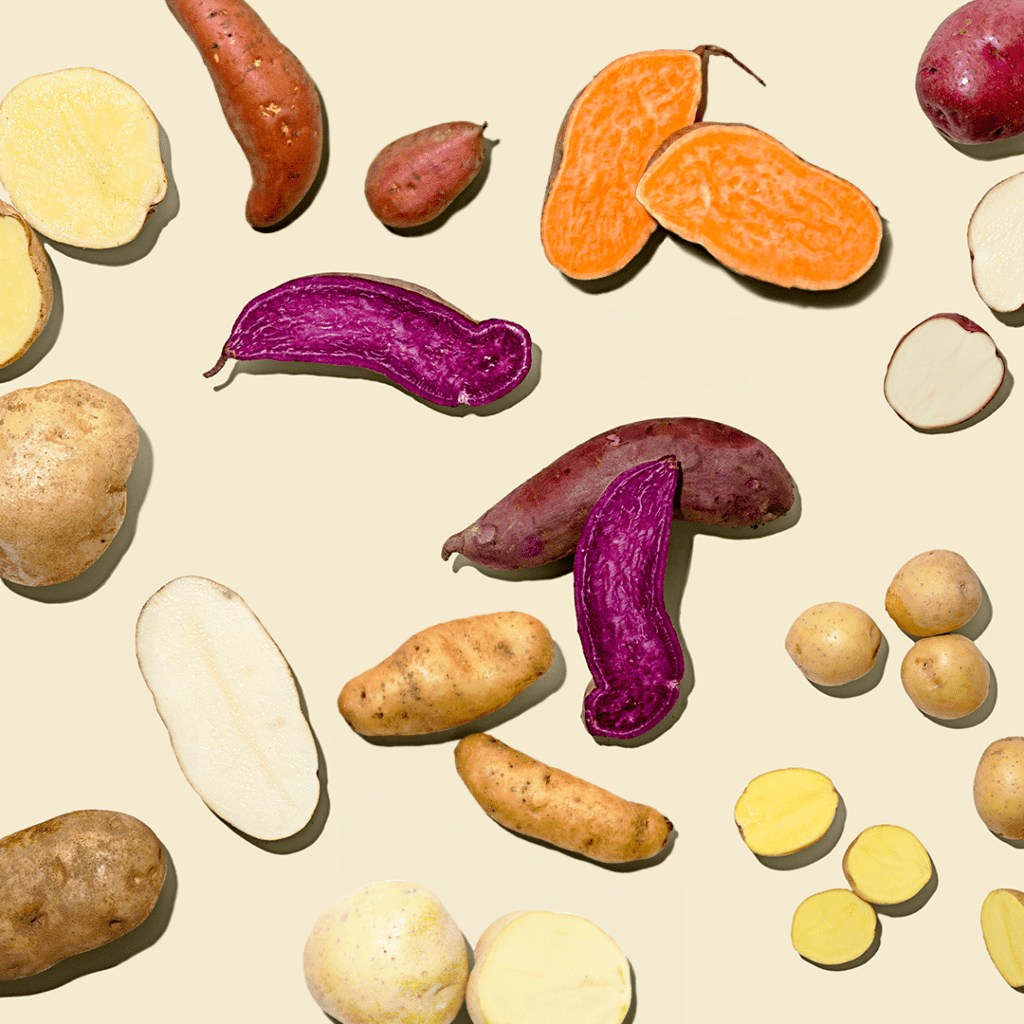
Potatoes are quite possibly the most versatile and ubiquitous veggie out there—just look to french fries, potato chips, and the countless potato-based sides. These days there seem to be as many potato varieties as there are ways to cook ’em, which is where our guide comes in. Whether you’re whipping up a weeknight roast, stocking up for the annual Thanksgiving mashed potatoes, or just want to try a new kind, this list should hold all the inspiration and instruction you need.
RED POTATOES
- The Look: Thin skin with a muted reddish-pink hue, and a crisp white flesh.
- The Shape: Small, either sphere- or egg-shaped, and mostly smooth.
- The Texture: Silky, waxy (read: not as starchy), and juicy, as far as potatoes go…
- The Best Use: Reds are your taters-of-all-trades. They’re small and versatile, with an ability to absorb whatever flavor you pair ’em with. Once boiled, they’re great for smashing and sautéing as a breakfast side, or halving for a cool and classic potato salad.
YUKON (GOLD) POTATOES
- The Look: Named after Canada’s Yukon River—once a gold rush hotspot—Yukon golds have an appropriately golden hue both inside and out.
- The Taste: Buttery and rich, with a slight earthiness.
- The Texture: Thin, smooth skin, and a creamy texture.
- The Best Use: Simple applications, such as boiling, baking, and mashing, allow their velvety taste and texture to truly shine.
YELLOW POTATOES
- The Look: Light, tan skin and creamy yellow flesh.
- The Shape: Some are marble-sized, others much larger; some are round, others more oblong.
- The Taste: Rich and buttery with a subtle sweetness.
- The Texture: Velvety, moist, and slightly waxy.
- The Best Use: Yellow potatoes are well-matched with the high heat of a grill or oven, where their skin can crisp and their buttery flesh takes on a caramelized sweetness.
RUSSET POTATOES
- The Look: Also called Idaho potatoes, russets are your quintessential spud, with skin that’s smooth and ruddy brown, and flesh that’s a pale white.
- The Shape: Medium to large in size, and almost always oblong.
- The Taste: Distinctly dense, floury, and fluffy, with a tinge of earthiness.
- The Best Use: Bring on the butter: Russets are on the drier side, meaning they’re highly absorbent. They’re ideal for mashing or baking, just be sure to poke all over with a fork before cooking so steam can escape.
FINGERLING POTATOES
- The Look: Fingerlings aren’t “new” potatoes*—they’re bred to be smaller when fully mature—and it’s not uncommon to find them in different colors: reddish-pink, yellow, or purple, with the flesh to match.
- The Shape: You guessed it! They’re named for their long, slender shape that’s more or less finger-length.
- The Taste: This heirloom variety is grown with taste and texture at top of mind. Flavor-wise, they’re similar to other (albeit larger) mature spuds, such as the Yukon gold.
- The Best Use: Simply wash and halve them—leaving the smooth, delicate skin as-is—then roast, bake, or boil to make the most of their velvety, dense texture.
SWEET FINGERLING POTATOES
- The Look: Think sweet potatoes—bright orange flesh, mauve skin, and all—except smaller (and more oblong).
- The Shape: Most sweet potato varieties can be harvested when they’re fingerling-size by choice, but other times by fate, like when unusual weather conditions yield tinier taters.
- The Texture: Sweet fingerlings aresofter-skinned and far less stringy on the inside than their larger siblings, but otherwise bear great resemblance.
- The Best Use: Wash ’em, halve ’em, and toss ’em on a baking sheet with a guzzle of olive oil and a liberal sprinkle of coarse sea salt (but don’t peel ’em!).
SWEET POTATOES
- The Look: Muted copper skin that conceals vibrant orange flesh.
- The Taste: The flavor they’re named for only deepens when cooked.
- The Texture: Soft, incredibly moist, and slightly stringy.
- The Best Use: Don’t peel those skins! They add to this sweet spud’s tastiness and nutrient offering (beta-carotene, among others). Chop crosswise into coins, then roast until glossy sugars start seeping out, flipping halfway through.
PURPLE SWEET (UBE) POTATOES
- The Look: Vibrant deep-pink skin and bright, marbled flesh that ranges from magenta to violet.
- The Taste: Slightly less sweet than other sweet potatoes, with flesh that’s dense, yet still moist and tender.
- The Best Use: If you’re swapping them for their orange counterparts, note that purple potatoes may require added cook time (or a higher temp) as they’re slightly starchier.
JAPANESE SWEET (OKINAWA) POTATOES
- The Look: Deep magenta skin and creamy-to-pale-yellow flesh. (When in doubt, picture the emoji. ???? )
- The Taste: A sweetness (of course!) that’s balanced by nutty, chestnut-like notes.
- The Texture: Despite their name, these have a denser, drier, and starchier flesh compared to other sweet potato varieties. (A word of caution: this means they’re a bit tougher to cut when raw.)
- The Best Use: They’re a one-to-one swap for typical sweet potatoes, but also for the starchier, not-as-sweet varieties in casseroles, mashes, or gratins.
*What are “new” potatoes?
You’ll often hear this in regards to red potatoes, but it can apply to any variety. It simply signifies that a potato was picked before it reached maturity (much like “baby spinach”).
Like this? Keep reading:
Everything You Need to Know About Mushrooms
